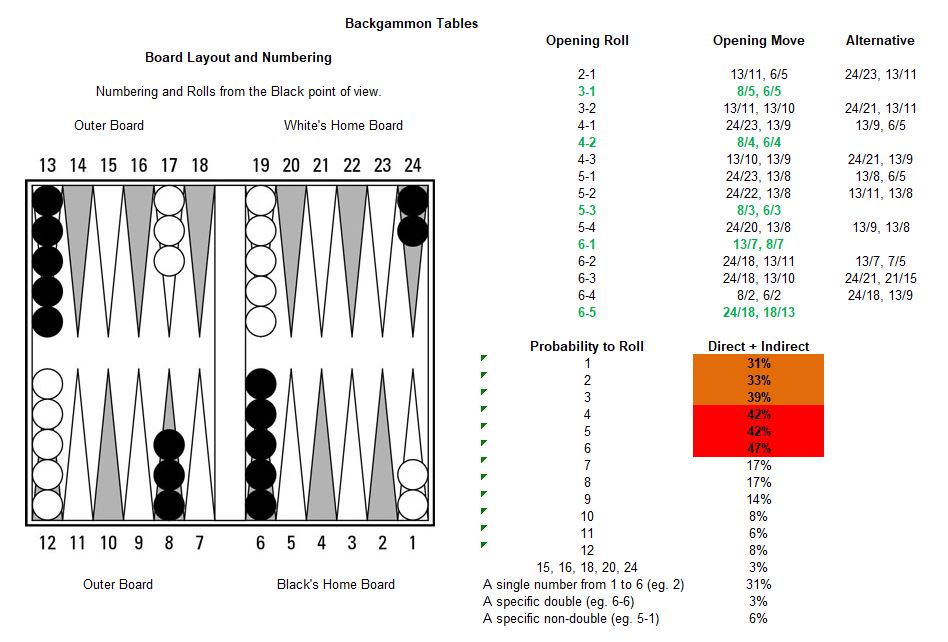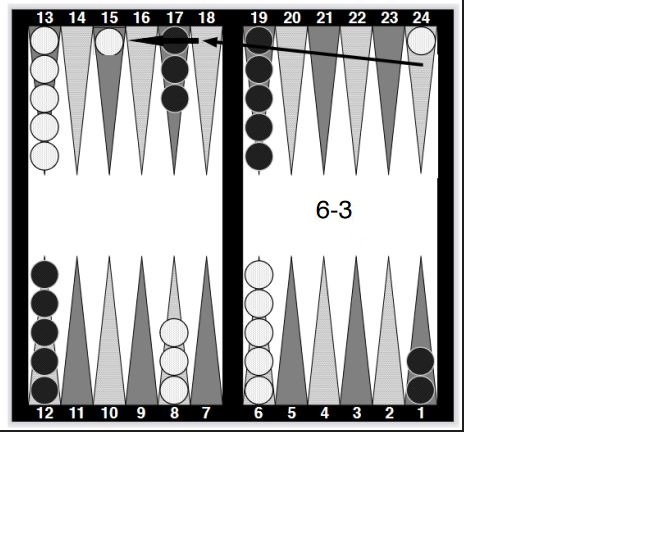Last updated on April 20, 2024
In this Deluxe Backgammon post for beginners, we are going to take a closer look at the 6-3 opening move. It is not one of the preferred opening rolls as it won’t secure a key point. There are two widely accepted plays for this roll. One is a clear gamble and the other applies a more balanced strategy. The idea is to choose the one that best suits your playing style and the state of the match. We will take an in-depth look at each of the plays below.
The two widely accepted plays for a 6-3 opening roll in backgammon are 24/18, 13/10 or 24/15. The 24/18, 13/10 play applies a balanced strategy by splitting the back checkers and bringing down a builder from your mid-point to the 10-point. The 24/15 play for the 6-3 initiates a racing strategy that escapes one of the back checkers into the outer board. Each of these moves has different benefits and risks. However, the 24/18, 13/10 is probably the more popular of the two moves.
24/18, 13/10
The 24/18, 13/10 play for the 6-3 opening roll adopts a balanced strategy. Using this play develops both sides of the backgammon board in a single move. The benefits are that it escapes one of the back checkers and moves a builder down from the stacked mid-point into the outer board. The risk involved with this play is that it leaves two blots on the board. In particular, your opponent will want to hold their valuable bar-point, so the blot on the 18-point will be attacked at the first opportunity.
There is a 47% chance of rolling a direct or indirect 6, so the blot is extremely vulnerable. However, the opponent really needs to roll a 6-1 to attack and secure the bar-point, otherwise, they will be vulnerable to a hit in reply. If the checker on the bar-point isn’t hit, then on the next move, you can attempt to secure the point with the rear checker or run the bar-point checker to safety. The builder on the 10-point is less of a target and can only get hit 14% of the time on the opponent’s reply. As it is still early in the game there is plenty of time to recover if either checker is hit.
This opening roll play in backgammon is generally seen as more constructive than the 24/15 play. The builder set up on the 10-point and the checker on your opponent’s bar-point puts pressure on your opponent because it creates two threats at once on either side of the board.
24/15
If you select the 24/15 play for the 6-3 opening roll you are triggering a running game. This move is good for this opening roll as long as you don’t get hit. Stage two of the plan is to move the checker to a secure position in your outer board after the opening roll. Alternatively, a follow-up roll of 6-3 or 5-4 will allow you to secure the 15-point. This would be ideal as both back checkers would have escaped and would sit in a secure position. However, this does rely heavily on the luck of the dice, rather than intelligent strategy or tactics.
The problem with the 24/15 play is that your opponent has a 36% chance of hitting in reply. A hit sends you back 9 pips in the race, with a checker on the bar. Your opponent also now has a builder in their outer board which is relatively safe from retaliation.
Rule of 8
The average roll in backgammon, after the opening move, is 8.17. At Deluxe Backgammon we refer to this as the rule of 8. It can be used to determine your position in the race. If you are not hit after making the 24/15 opening play you take a one pip advantage on your opponent, based on the rule of 8. This gives you a slender lead if your preferred style of play is running.
In comparison both of these plays involve risk. The blot on the bar-point for the 24/18, 13/10 play is certain to be a target, likewise the blot on the 15-point for the 24/15 play. Assuming that both blots are missed, which play gives the best structure to the board? The answer has to be the 24/18, 13/10 move. This is because of the opportunity to secure the bar-point on the next roll. It also leaves a useful builder in the outer board on the 10-point. The 6-3 opening is never going to be anyone’s favourite roll, but at least there are two ways of making the move depending on your style of play.
Rollouts
The XG Mobile Backgammon rollouts show that the 24/18, 13/10 option comes out narrowly on top of the 24/15 option. Hopefully, this post will give you some guidance on how to play the backgammon 6-3 opening move.
Related content
Backgammon opening moves, a simple list.
Backgammon opening moves, a complete list.
Read about the general principles for replying to the opening moves.
Backgammon opening theory at Wikipedia.




I don’t like the backgammon opening points where you are forced to leave a blot. I’m a conservative backgammon player and tend to build towers. To me the 6-3 opening is forcing a running game strategy. Thanks for the backgammon playing guides, I am slowly working my way through them and I’m seeing my backgammon improve. In my local club, I have recently moved to the backgammon intermediates group with your advice, thanks again!
Hi Shelley, towers or candlesticks are generally not a good idea in backgammon. They may look safe, but they lack flexibility, which will give you limited options on the next roll. Sometimes, you just have to take a calculated risk for your next move, keep in mind the risk may not pay off. Take a look at our probability and strategy posts. I really appreciate your time in commenting at Deluxe Backgammon, thanks, Jason.
Not my favourite backgammon opening, but this has given me a better idea on how to play the 6-3, thanks.